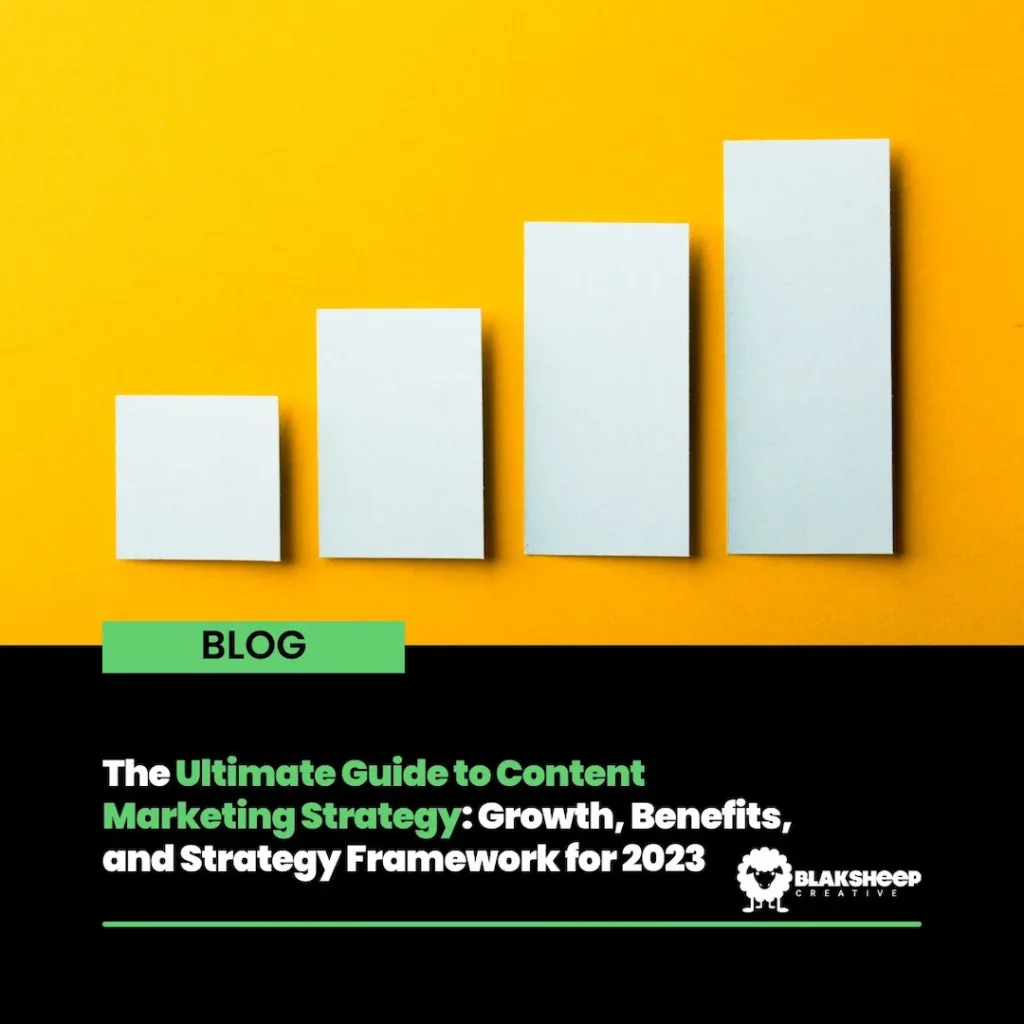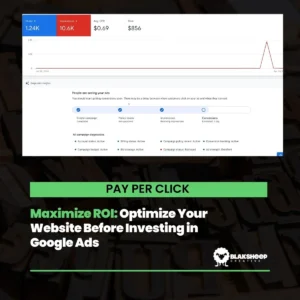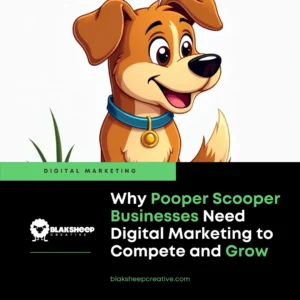As content marketers, we all know the importance of having a content marketing strategy in place. But with so many changes happening in the content marketing landscape every year, it can be hard to keep up and ensure your content reaches its full potential.
You want to ensure you’re staying ahead of the curve and creating content that will engage your audience while also helping you reach your business goals. You need an effective content marketing strategy in 2023 but don’t know where to start or how to create one that works best for you.
That’s why we’ve created this Ultimate Guide To Content Marketing Strategy For 2023! This guide will take you through everything from increasing website traffic and improving brand awareness to developing a comprehensive content framework for success this year.
So let’s get started!
And If you’re exploring how AI is changing the way content is discovered, don’t miss our guide on getting your business noticed by ChatGPT and Bing. It’s packed with simple strategies any small business can use to stay visible in an evolving search landscape.
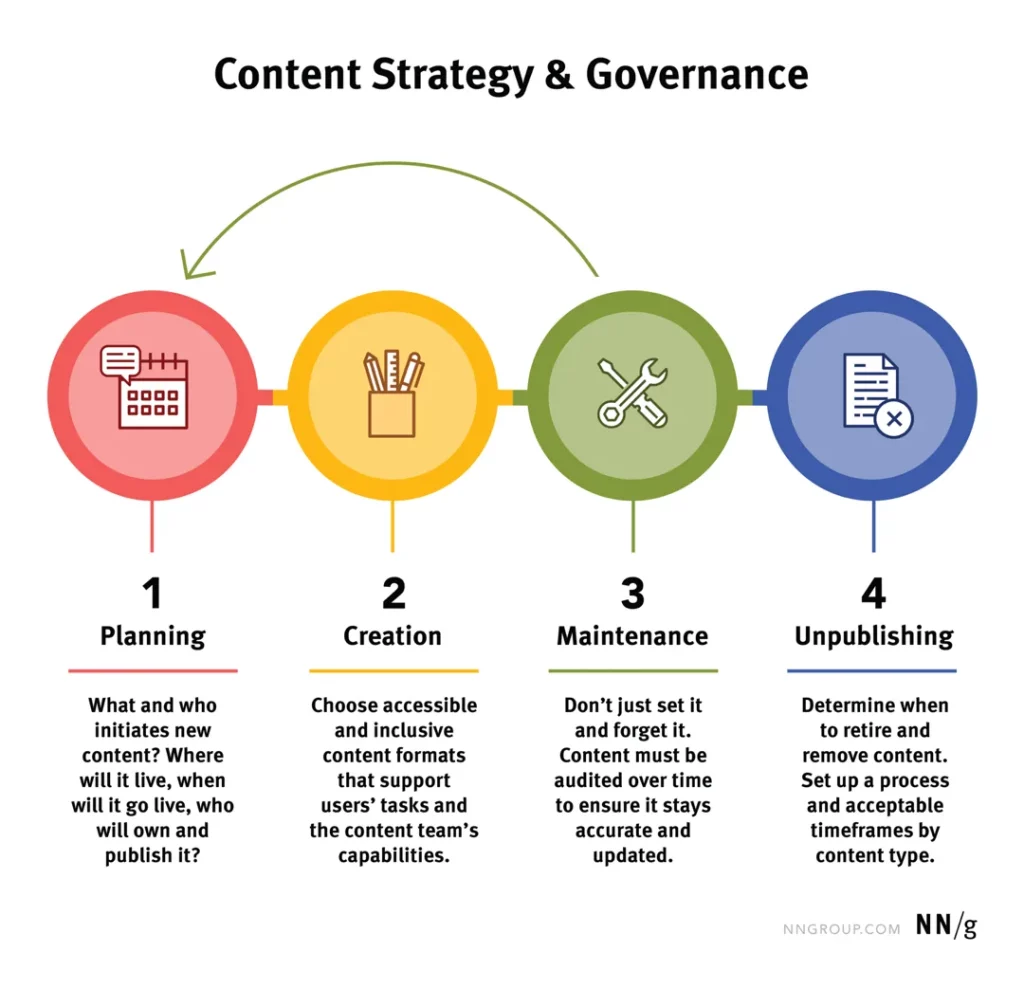
Image Source: Nielsen Norman Group
What is a Content Strategy?
Before we dive into a content marketing strategy for 2023, let’s quickly define what content strategy is. Simply put, content strategy is the process of planning, creating, and maintaining content that meets the needs of your target audience while also helping you reach your goals.
Content can include anything from blog posts and videos to webinars or podcasts tailored to your specific content goals.
Having a content strategy in place ensures your content is reaching its full potential and helping you achieve the success you deserve! Do you need help creating a content strategy for your brand? Contact us today or visit our content marketing services page to learn more.
Here are some of the most critical questions you must ask yourself when developing your content marketing strategy for 2023:
1. Who will be reading your content?
Your content will be read by various audiences, such as customers, potential customers, business partners, employees, and more. It is crucial to consider the needs and preferences of each group when developing your content strategy to reach as many people as possible with relevant and engaging content.
For example, we have a client who leans heavily on influencer marketing. Why? Because their product is cutting-edge and they must stay on top of content marketing trends like influencer marketing to reach their target audience.
The moral of the story – use actual first-party data to find what resonates with your audience and create content that meets their needs.
By having a good idea about who will be reading it, you’ll be able to craft content that resonates with that specific reader. You will also be able to tailor your content marketing strategy to their liking, interests, and needs.
To maximize reach, it is essential to research target audiences on an ongoing basis and adjust your content accordingly. This could mean monitoring comments and feedback or leveraging analytics tools to understand the readers better. A tailored approach ensures that the right audience is always reached with a message that resonates.
2. What content goals do you want to achieve?
You must also consider your content goals when developing a content strategy for 2023. Are you looking to increase website traffic, generate leads, improve brand awareness, or something else entirely? By clearly defining your content objectives, you can ensure that your content is tailored to your specific needs and meets its goals.
For example, at the beginning of 2022, we had a client looking to increase website traffic and return visitors. To achieve this goal, we focused on creating content with SEO best practices in mind and content pieces that were helpful to our target audience. We also optimized and rewrote existing content to ensure that it aligned with what our target audience was searching for.
3. What problem will you solve for your audience(s)?
When developing a content marketing strategy, it is vital to identify the problem you will solve for your audience(s).
By understanding their pain points, goals, and desires, you can create helpful content that helps them overcome these challenges.
A sound content strategy should support both sides of your product—those still figuring out their main challenges and those who have already identified them using your product. Your content should reinforce the solutions you’re offering and make customers more qualified users of your product.
Also, consider things like:
- Search intent – your content should match the user’s search intent and answer their questions
- Content formats – content can come in various forms, such as blog posts, videos, podcasts, webinars, etc.
- Customer preferences – you should tailor your content to the needs and preferences of your customer base.
As you can see, there’s more to reaching your intended audience than talking about your brand and accomplishments. Knowing your content goals, understanding the needs of your target audience, and creating content that solves their problem are all essential components to content success.
4. What makes you unique?
Your content strategy should be unique to set you apart from your competitors. It should focus on what makes your organization worth buying from and what makes your content stand out from the growing glut of content published daily.
To do this, you need to identify the “one thing” that will set you apart from other brands and content creators. Ask yourself, what content can you create that no one else is? How can you make interesting and shareable content for your target audience?
Do you need help figuring out what makes your brand different than your competition? We can help you with that. Contact us today to learn how we can help you stand out from your competition and grow your business exponentially in 2023.
5. What content formats will you focus on?
In this era of content, content comes in many forms. From blog posts and videos to webinars or podcasts tailored to your specific content goals, there are countless content formats you can use depending on your audience, budget, time constraints, and content goals. Consider what content formats will work best for your content strategy before starting.
For example, if our client needs straightforward content to consume and share, we recommend content formats like infographics, videos, or podcasts. These content formats are highly engaging and easy for readers to understand. On the other hand, if a client wants content with in-depth insights and data analysis, we recommend content types like white papers or e-books.
6. How will you measure content success?
Finally, it’s crucial to consider how you will track your content marketing efforts and measure content success in 2023.
To do this, it is crucial that you create content with specific goals in mind and then determine the key performance indicators (KPIs) you need to measure content success. Typical content marketing KPIs include website traffic leads generated, content downloads, and content shares.

Image Source: Rhythmsystems.com
By measuring content success through these KPIs, you can track content performance and optimize your content for better results. You can also use this data to inform future content strategies or refine existing ones to ensure that your content reaches the right audience and drives the desired results.
Don’t get hung up on vanity metrics. They’ll do you no good! Read our recent article to learn what vanity metrics are and why you shouldn’t pay them too much attention.
7. What channels will you publish on?
When it comes to publishing channels, there are a variety of options available. Depending on your brand and content strategy, you may choose to publish on owned properties such as your website and blog or social media networks like Facebook and Twitter. You could also consider other channels like newsletters, videos, podcasts, and more.
8. How will you manage content creation and publication?
Whether you have an entire digital marketing team, a two-person content team, or just you, content creation and publishing require a content workflow.
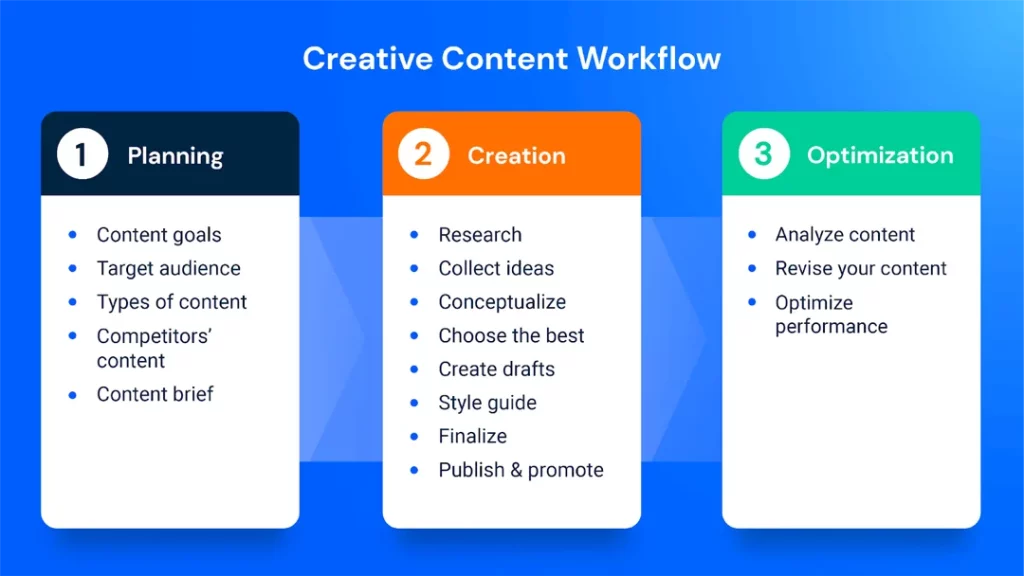
Image Source: Similarweb
This content workflow should include all the steps from content research to content ideation, content production, content review and approval, content distribution and promotion, data collection, and analysis. Here are some steps you can use to become an expert content marketer in no time:
- Determine who is responsible for content production and who will deliver individual content items.
- Assign roles and responsibilities to the team members, including in-house content creators and specialists in video creation, podcasting, or graphic design freelancers.
- Ensure that everyone has the necessary tools and resources (e.g., equipment for podcasting and creating professional videos).
- Work out a content workflow process (e.g., outline approval process) for each type of piece you wish to create (e.g., blog post). This will ensure consistency across all content your team members or freelancers make.
- Create a calendar to track when each piece needs to be published, so they don’t overlap with other pieces in the future.
- Make sure all team members know what needs to be done before starting work on any given piece of content: outlining topics, gathering research materials, etc.
Get a Free Content Calendar
Tell you what. Fill out the form below, and we’ll give you a free content calendar that you can use to plan out your next year of content. No strings and no obligations. We just want you to succeed.
Image Source: SEMRush
Why do you need a content marketing strategy in 2023?
There’s no way around it. To succeed in content marketing in 2023, you need a content strategy. A content strategy is essential for helping you understand your target audience, set content goals and objectives, create content that resonates with the right people, and measure content success.

An effective content strategy will also help you stay organized so that all your content pieces don’t overlap and content production remains consistent. Creating a content marketing strategy for 2023 is the best way to ensure that your content is effective, efficient, and delivers real results. Here are some reasons you need a content marketing strategy in 2023:
1. To reach a targeted audience
A content marketing strategy can help you reach a targeted audience in 2023 by providing the right content for the right people.
By clearly defining your target audience or buyer persona, you can produce more relevant and valuable content that meets their needs. To learn more about creating buyer personas, check out this excellent resource from Hubspot.
By conducting market research each year and understanding who your readers are, what they want to read, and how they prefer to receive it, you can tailor your strategy to meet their expectations to grow your audience.
Additionally, using a variety of content types and channels will allow you to deliver different content for every kind of reader or viewer while still engaging everyone in your company’s customer base.
2. To create high-quality content
Creating high-quality content for a content marketing strategy in 2023 is essential because it will help your organization stand out from the competition and gain more visibility. High-quality content can attract more readers, generate more leads, and build trust with potential customers.
It can also improve your search engine optimization (SEO) rankings, leading to increased website traffic and conversions.
Additionally, high-quality content can be used as a valuable resource for years to come so that it continues to drive positive results for your business.
3. To engage with your audience
Engaging with your audience through social media can help build your brand’s presence and bring people to your own space.
By engaging with your audience, you can gain insights into their lifestyle, concerns, problems, and needs. This allows you to create buyer personas to help shape your content marketing strategy in 2023.
Additionally, engaging with customers on social media helps build loyalty that extends beyond purchasing products or services from you. Remember, repeat visitors will likely be more loyal to your brand and content.
4. To increase website traffic and conversions
By creating high-quality content, social media shares, and others linking to your articles, website pages will have more perceived social proof and authority in visitors’ eyes. This will increase traffic to the website as well as SEO benefits.
The increased traffic from a content marketing strategy will be one of the easiest tools for boosting conversions for your business in 2023. Additionally, each link from another site to your pages will bring referral traffic where people click from those other pages to visit yours.
5. To increase brand awareness
Brand awareness will be a critical component of content marketing in 2023. A content strategy that uses multiple content formats and marketing channels can help build brand recognition more quickly than traditional advertising methods.

By creating content that resonates with your target audience and distributing it across multiple platforms, you can increase the reach and visibility of your brand to potential customers. You can even use the image above to find out where to start to find your target audience.
6. To increase brand trust
Let’s face it; people want to do business with companies they trust. Content marketing can build and strengthen relationships between your company and customers, resulting in higher levels of brand loyalty.
You can create relationships built on trust and credibility by consistently delivering valuable content to readers. This will help increase the likelihood that someone will purchase from your business or recommend it to a friend.
7. To increase website authority
Creating high-quality content, social media shares, and having others linking back to your articles can increase website authority. This increases the perceived social proof and authority of your website pages in the eyes of visitors and Google.
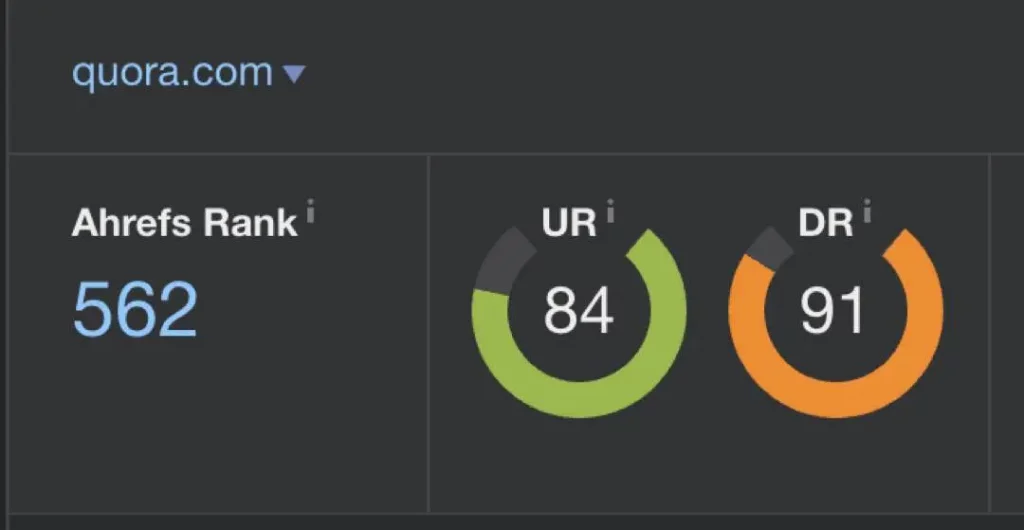
And with this authority comes better search engine ranking and more traffic. Content marketing strategies focusing on content optimization, keyword research, link building, and other tactics will help improve website authority in 2023.
8. To increase website traffic from social media
When you produce value-driven content, it can be shared on social media and bring more people to your website. Similarweb did a study of over 3.25 Million websites in 2020 and found that Facebook was generally the largest traffic generator for most niches and:
- Facebook delivers 65.36% of all social media traffic: more visits per month than all other social networks combined.
- Instagram drives very little traffic: under 1% overall across all niches. Even fashion and beauty brands that were launched by Instagram influencers (e.g., Kylie Cosmetics) receive less than 5% of their monthly visits from Instagram — while search brings in about ten times as many.
- The most reliant niche on Facebook is Business and Marketing, which gets 13.52% of its traffic from the network.
- Reddit drives over three times as much traffic to blogs as YouTube.

Creating content that resonates with your audience and is optimized for each platform will help you reach a larger audience and increase website traffic from social media in 2023. Additionally, you should tailor your content to the channels it is shared on to engage users and encourage them to click through to your website.
9. To increase lead generation
Content marketing can help you generate leads for your business in 2023 by creating content that resonates with your target audience, optimizing content for search engines, engaging with followers on social media, and using content to build trust and authority among customers.
Now that you know the benefits of having a content marketing strategy in 2023, it’s time to start creating content to help you reach your goals.
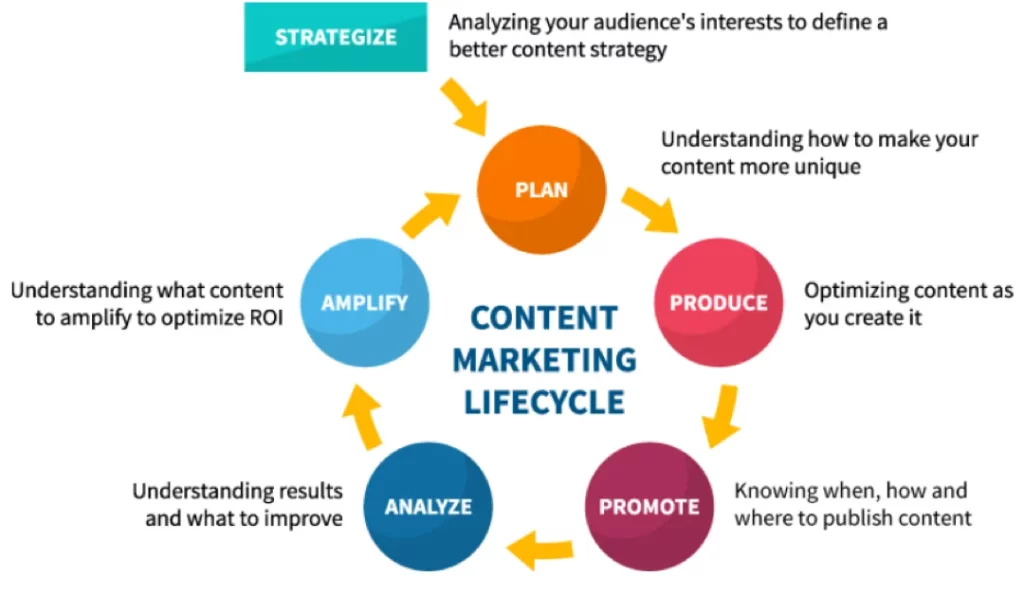
How to create a content marketing strategy?
Whether you’re creating content pages, social media posts, short-form videos, or blog content, there are vital steps to creating a content marketing strategy that will make your content successful. Look at the typical content marketing lifecycle above and use it as an guide as we proceed.
Step 1: Audit Your Existing Content
Before creating content, look at some of the content you’ve created for the past few years. Does any of it resonate with your target audience resonates? You may be able to repurpose content or update content to make it more effective. Yes, repurposing content is an effective content strategy.
Step 2: Research Your Target Audience
Understanding your target audience and what content resonates with them is essential. You can use a combination of market research, customer surveys, and competitor analysis to gain insights into their needs and interests. Pay attention to top content marketing trends to gain valuable insights about the content preferences of your target audience.
Step 3: Create Buyer Personas
A buyer persona is a fictional representation of your ideal customer based on data and research about your target audience. Creating buyer personas will help you create content that resonates with the right people.
Step 4: Establish Your Content Marketing Goals
Without clear goals, you’ll be unable to measure the success of your content. When formulating content goals, think about what you want to achieve with content marketing and how content can help you reach these objectives:
Step 5: Develop An Editorial Plan
Content marketing trends may come and go, but one thing remains the same. You must be consistent to reach your content goals, which means creating content regularly.
Develop an editorial plan outlining how often you will publish content and the topics you’ll cover for 2023.
Step 6: Plan Content Production
While your editorial plan is the what, content production is the how. Content production involves content creation, content optimization, content promotion, and content measurement.
Step 7: Plan Content Distribution
Now it’s time to get your content out there. Distribution involves content promotion and syndication— sharing content on other websites to increase reach.
Step 8: Measure and Analyze Your Content Performance
Here’s what will separate you from the content marketing pack in 2023: data-driven content.
Analyze content performance metrics to determine which content resonates with your audience.
Use this data to fine-tune content strategy and create content to help you reach your goals faster. You should:
- Analyze user behavior: Track the number of unique visitors, pages per session, and bounce rate for each piece of content.
- Analyze engagement: Monitor likes, shares, comments, and mentions related to each piece of content to understand which pieces are most engaging with your audience.
- Analyze SEO results: Monitor organic traffic and dwell time for each piece of content to see how well it performs in search engines compared to others in the same industry or niche topic area.
- Measure company revenue: Track how many leads are generated from each piece of content and any existing leads affected by it so that you can measure its success at converting readers into customers or subscribers, if applicable.
Step 9: Optimize Your Content
Now that you know which content works and which doesn’t, it’s time to optimize the content that resonates with your target audience. Optimize content structure and layout, headlines, length, images or visual elements, and metadata to give readers a better customer experience when they visit your content.
By following these steps and leveraging data-driven insights to create content that resonates with your audience, you can create a content marketing strategy for 2023 that will increase website traffic, improve brand awareness, and drive conversions.
With an effective content marketing strategy in place, you can ensure that your content stands out from the competition in 2023.
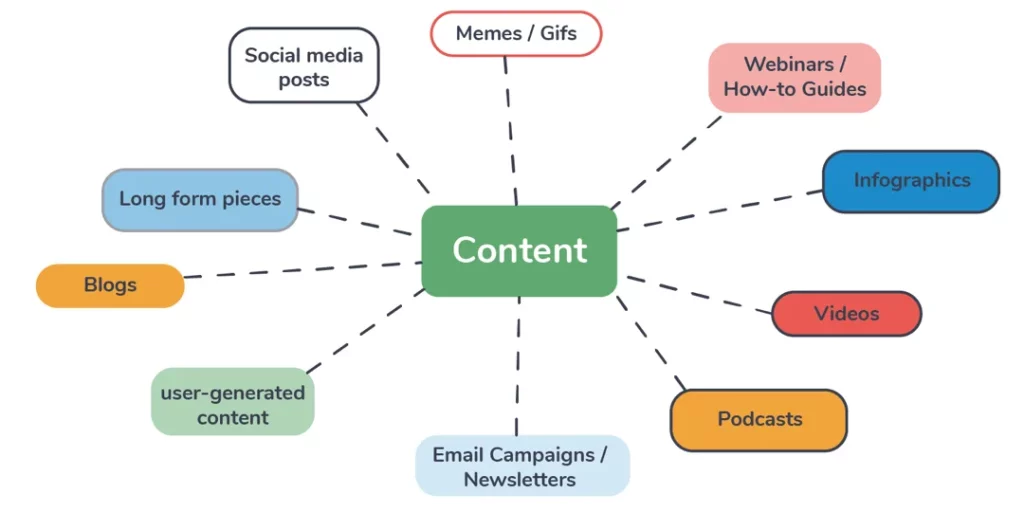
Types of Content You Can Create in 2023
From static content like blog posts and ebooks to interactive content like webinars, content marketing in 2023 will offer many possibilities for content creation. Here are some content types you can consider as part of your content strategy:
- Blog Posts
- Ebooks
- Videos
- Podcasts
- Webinars
- Infographics
- Social Media Posts
- Interactive Content (Augmented Reality/Virtual Reality)
- Case Studies
- White Papers
By staying up-to-date with content marketing trends and leveraging the right content types to reach your goals, you can create an effective content marketing strategy that will help drive results in 2023.
FAQ
And now, some of the most frequently asked questions about content marketing and some actionable advice to help you get started:
A content marketing strategy is a comprehensive plan for creating content that resonates with your target audience and increases website traffic, brand awareness, and customer conversions.
Lorem ipsum dolor sit amet, consectetur adipiscing elit, sed do eiusmod tempor incididunt ut labore et dolore magna aliqua. Ut enim ad minim veniam, quis nostrud exercitation ullamco laboris nisi ut aliquip ex ea commodo consequat.
Content marketing can help your business in several ways. It can drive website traffic, lead generation, and brand awareness. It can also help build relationships with customers by providing content that is valuable and engaging to them. Business owners can also use content marketing to improve SEO rankings for relevant keywords, increase conversion rates, and establish thought leadership in their industry. And if you’re doing it right, better search results = more website traffic = more leads and sales. In short, content marketing can be an invaluable tool for helping your business succeed in 2023 and beyond.
• Cost savings
• Increased sales
• Better customers who have more loyalty
• Increased website traffic and new leads
• Flexibility to experiment with other marketing tactics such as sponsored content, social media advertising, and distributed content
• Ability to educate target prospects and generate awareness for your brand
Content marketing can be divided into different types based on the purpose and format of the content. Common types of content include:
• Infographics: Visual representations of data that are easy to understand and share online.
• E-books: Longer, more in-depth pieces of content designed to provide detailed information about a particular topic or industry trend.
• Whitepapers: Research papers that explore topics in greater depth, usually aiming to drive leads or sales for a company’s products or services.
• Social Media Posts/Campaigns: Social media posts that promote brand awareness, drive engagement, and encourage people to take action, such as sharing or clicking on links within the post itself.
• Case Studies & Success Stories: These stories highlight how companies have successfully implemented specific strategies or tactics to achieve success. They typically focus on one company’s story but may also feature insights from other companies that have experienced similar successes.
Ask two content marketers, and you’ll get three different answers. But the truth is that the optimal content form depends entirely on your goals and intentions. Short-form content can be used for brand recognition and awareness, whereas long-form can help build trust and customer loyalty by going deeper into the topic of discussion. Ultimately, determining whether to use short-form or long-form comes down to understanding your audience’s preferences and needs.
1. Set Your Mission and Goals: First, you must set your mission and goals for the content marketing strategy. What do you hope to achieve? What are your long-term goals? What are the short-term goals that will help you reach those long-term ones?
2. Establish KPIs: Once you’ve decided on your mission and goals, it’s time to establish key performance indicators (KPIs) that will help measure progress toward achieving them. These should be specific, measurable objectives that can be tracked over time so you know if they’re being met.
3. Know Your Audience: Next step is to know your audience – who are they? Where do they hang out online? What type of content do they respond well to most often? This information will help inform how you create content pieces for them in the future and where exactly it should be distributed (i.e., social media channels).
4. Assess Current Position: Before creating an effective strategy, it’s vital to assess your company’s current content marketing efforts. How is it performing compared with competitors or industry standards? Are there any gaps in coverage or opportunities
The key components of content marketing include:
1. Brand positioning: A clear understanding of the brand’s identity and how it should be portrayed to target audiences.
2. Owned media value proposition: An explanation of the benefits that come with consuming content from a particular source.
3. Business case: An analysis that shows how content marketing will lead to increased profits for your business.
4. Strategic plan: A roadmap that outlines the steps needed to implement a successful content marketing strategy, from creating relevant content to measuring its effectiveness.
When it comes to content marketing, there are a few best practices to keep in mind:
1. Group your content into a few core buckets, such as videos, blogs, ebooks, and microsites.
2. Design a “best practices” workflow for each core type of content with steps such as where it begins (e.g., who owns the business requirements and brief development process), when and where resources need to be turned on/off (e.g., who is responsible for final output), how feedback/approvals are coordinated (e.g., how to measure each step).
3. Meet with stakeholders/team members to ensure they understand the new process and are on board with it before implementing it across the entire organization or departmental level(s).
4. Document this new process in writing, so everyone is clear about what needs to be done from start to finish – this should also include any training that may be required for staff members working on these projects if they haven’t been involved in similar initiatives before.
5. Test out the new process by running through some mock scenarios or live projects using actual data; identify gaps or breaking points that need addressing ASAP before rolling out more broadly.
1. Check Google Analytics to see how your content is performing. Look at each piece of content’s engagement and conversion metrics and overall website traffic stats.
2. Measure social sharing activity using tools like Buzzsumo and other social analytics platforms.
3. Use tools like SEMRush to monitor progress towards goals such as increased awareness or higher engagement rates with targeted audiences (if applicable).
4. Repeat these steps regularly throughout the life of your content marketing strategy so that it remains up-to-date with current trends and data points relevant to success measurements!
Here are some content marketing trends to watch out for in 2023
We predict artificial intelligence will be one of the top content marketing trends for 2023.
Dive deeper into our insights on the impact of AI in content marketing for 2023. Explore our detailed analysis here: SEO in the AI Era.
Machine-generated content will make creating content easier and more efficient, allowing content marketers to focus on creating content that resonates with their target audience.
Optimizing your content for voice searches will become more important as more internet users browse from their smart devices. A recent study revealed that a remarkable 21% of participants utilize voice search queries weekly.
Short-form video content will become even more important to content marketers, given the continued success of TikTok and other social media platforms that rely highly on video content.
Many marketers will adopt automation tools to streamline processes and gain insights quickly. These tools can reduce the manual labor required to get a job done, allowing marketers to focus on more critical tasks. These automation tools can also be leveraged to monitor content marketing campaigns’ performance, allowing marketers to quickly identify which strategies are proving successful and modify their current tactics accordingly.
Moreover, automation can help expand a business’s reach by enabling marketers to connect with potential customers who have not interacted with the company before. Content marketing trends in 2023 will also include leveraging data-driven insights through in-depth analytics. Adopting this approach can offer detailed overviews of how consumers perceive a brand’s content and allow marketers to make informed decisions about their strategy.
Additionally, interactive content such as augmented and virtual reality will become more popular in the coming years. Interactive content is a powerful tool for engaging customers and making content more enjoyable and memorable.
Finally, personalized content will continue to be an important content marketing trend for 2023. Companies will use data-driven content to provide customers with content that aligns with their interests, preferences, and needs.
Does all of this Sound Overly Complicated?
We get it. It seems like a whole lot of work to put together a content marketing strategy, but it doesn’t have to be overwhelming. The good news is BlakSheep Creative is here to help. We’re content marketing experts with years of experience helping brands create content that helps them reach their goals.
So, if you need any assistance with content strategy in 2023, get in touch!
We’ll help you map out a plan that gets results.
After all, content is king, and content marketing is the key to unlocking its full potential. With a content marketing strategy tailored to your unique business needs, you’ll be ready to take on 2023 and rise above the competition!
Good luck with your content marketing journey in 2023! We’re here to help if you need it. Feel free to reach out with any questions or fill out the form below for a free content marketing consultation
Happy content marketing!
